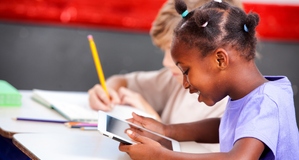Featured Article:The Implementation of Social Software in Authentic Literacy ActivitiesThe Role of the TeacherThe aforementioned observation by Furr et al, (2005) concerning constant monitoring and redirection by teachers, is reinforced in a number of other studies and articles where the implementation of technology in literacy lessons has been observed or discussed. Firstly, Parke (1970) carved out an ambitious description of the teacher who is “diagnostician, planner, counselor, and guide, instructor, organizer of class activities and environment, integrator, and evaluator” (p. 11). Secondly, in a sentence that is fitting to authentic literacy, Parke stated, the teacher “must know the world of each learner in order to help him relate what he is learning to that world” (p. 11). Thirdly, as already discussed, the teacher has to be continually aware of how the implemented technology is affecting the learning outcomes, the learning environment, and each student. The teacher primarily takes on the role of facilitator or moderator; once the students began working on the task at hand, the need for direct instruction is greatly lessened (Wheeler et al., 2008; Carroll, 2013; Minocha, 2009).This role appears to complement authentic literacy activities, even those without technology implementation. Sanacore (1997) and Oldfather (1995) argued that the role of instructor, or the teacher-directed approach, “stifles students’ opportunities for authentic self-expression” which “appears to diminish student’s intrinsic motivation for literacy learning” (Sanacore, p. 568). However, the role of teacher as facilitator or moderator can be conflicted with educators who see their primary role as instructor, or “‘delivering’ education and instruction” (Minocha, 2009, p. 387). In fact, the role of instructor, while somewhat not in vogue, still has ample merit. Educators who embrace the role of facilitator or moderator should heed the warnings from Clarke and Feldon (2005) and Bernard et al. (2004), who stated that student interest does not equate with more learning, and such interest displayed in multimedia courses resulted in significantly less learning than would have occurred if the educator took the role as instructor. Clarke (1982) strengthens this observation when he concluded that students tend “to report enjoying the instructional method from which they learn the least” (p. 99). Perhaps it is the aforementioned assertions by Clarke and Feldon (2005), Bernard et al. (2004) and Clark (1982) that mark continuing or formative assessment as a crucial component, or a point of discussion, in many of the studies and articles. In fact, assessment of students engaged with technology has been a thorny issue for decades (Silberman, 1967), leading to a discussion surmising that the “resistance to individualized instruction may not stem from conservatism as much as from the management problems associated with the newer techniques” (p. 631). Moreover, in collaborative learning environments, Minocha (2009) addressed the difficulty for teachers to apply an individual mark on work that was completed collaboratively and notes, “the lack of assessment proved to be an issue in a number of the case studies showing that this area is perhaps still somewhat immature in its development (p. 391). The need for more research and discussion on developing specific assessment criteria when using social software, along with the changing practices of teaching multimodal literacy, was discussed in some studies (Walsh, 2010; Wheeler et al., 2008). Yet, these studies can be juxtaposed with other studies where addressing these issues was either lacking or not adequately discussed (Carroll, 2013; Edwards-Groves, 2012). Nevertheless, one common theme throughout the discussion was the importance of the educator to be actively involved in the design of the technology implementation as well as the need for strong professional learning communities. While it is unlikely that Silberman (1967) was considering online learning with the use of social software, he, nevertheless observed what most of the current researchers assert today: It is important that teachers “participate in designing the systems to be used in their schools” (p. 14). Current research not only discusses the importance of the teacher’s involvement, but also the need for the teacher not to work in isolation. Just as the implementation of social software in authentic literacy settings invites students to work collaboratively, so too is it vital for the educator to be connected to a strong support team, including other educators. Cloonan (2010) observed, “the participating teachers acknowledged that through collaborative engagement with their peers and researchers, and documentation of their practices, they reviewed, refined and reframed their practices” (p. 256). Similarly, the importance of professional communities was observed in Carroll (2013) where teachers become “central players and their perceptions and practices are pivotal in improving pedagogy” (p. 14). Teale and Gambrell (2007) cited a “close connection between high quality literacy instruction and sustained cumulative professional development for teachers” (p. 737). Edward-Groves (2012) argued the necessity for providing “site-based professional learning projects conducted over time” (p. 111), allowing teachers to embed technology not just as a technical practice but “as an interactive pedagogical concern” (p. 106). Edward-Groves observed, “How teachers actually understand changing literacies, and adjust their practices to account for the challenges and the opportunities that technology present for pedagogy, remains an ongoing issue” (p. 100). Indeed, most of the teachers involved in the research were adept with social software and expressed a high level of comfort working with technology. If schools expect more teachers to start implementing technology in their classroom environments, it seems only logical that strong professional communities, where experienced teachers can collaborate with inexperienced teachers, would be highly beneficial and crucial to the implementation process. The Role of the StudentWhen students participate in authentic literacy activities that include the use of technology, such as social software, their role in the classroom changes. This was evident across a range of ages. The encouragement of discourse as students read and explore texts is inherent in authentic literacy. “The persistence of discourse style suggests that learners need to construct meaning in their own natural way in transition to acquiring the fullest range of literate discourse,” emphasized Barnitz (1994, p. 587). Because of the students’ active engagement in constructing their own meaning in authentic literacy activities, there are times where the students become participants and partners in the learning process (Purcell-Gates, Degener, Jacobson & Soler, 2002). As participants and partners, one study noted that the students engaged in intense interaction and collaboration and became self aware of the dynamics of group work, including: team problem solving; creating one idea or vision from a number of perspectives; the importance of genuine consideration and cooperation; relying on other members for help and guidance; the need for good listening skills, and the potential efficiency and creative power when working together (Edward-Groves, 2012). Students were also empowered with a “sense of ownership” and the opportunity to make choices when they worked collaboratively on assignments that engaged them in the development of multimodal literacy skills (Carroll, 2013). This empowerment of students in the learning environment also led students to see themselves as “‘experts within the room’ in aspects of technology” (Cloonan, 2010, p. 255) In some instances, social software played an important part in student retention as students received and provided support to other students. This community building within certain classes led to students staying in touch even after course completion (Minocha, 2009). The importance of the online communities to students is echoed as well in Wheeler et al. (2008) where it is stated, “For many learners, membership of a community may be particularly crucial, affording them the facility to return regularly to the grounding of a social network…” (p. 989). Wheeler et al. (2008) also addressed an issue when some students contribute less to an online discourse than others. Wheeler et al. (2008) and Beudoin (2002) stated that earlier studies indicate students learn even when they do not contribute directly. Wheeler et al. (2008) implored teachers engaged in these activities to sometimes take a “laissez-faire” attitude if “all members are deemed to have contributed something within a defined period” (p. 990). In fact, Beudoin (2002) suggested students who maintained a low visibility could be committing more of their time to reflection and processing of course material. Muchnik (1969) discussed the refusal of teachers to recognize “a new visual or electric” as a type of literacy (p. 5). Quoting McLuhan (1967), he illustrated the educational institution’s suppression of “all the natural experience of youth” and their delight of literature as well as “the beauty of the new technological environment [and] the environment of popular culture” (p. 5). These words of Muchnik (1969) and McLuhan (1967) still hold much weight over forty years later as students engage, across a wide range of subject areas, in multimodal literacy activities in authentic learning environments. Digital technologies are fundamentally shifting the way students learn (Edward-Groves, 2012). Nichols (2008, as cited in Edward-Groves, 2012) maintained, “today’s students thrive on the interconnected utility of technology, creativity, social interaction and connections with community” (p. 99). When these opportunities are available to students, it has a significant impact on their roles as students, particularly on how they interact, share, work and play together in the learning environment. The “connections with community” discussed by Edward-Groves will be explored next with a focus on the importance and impact of having an authentic audience.Continued on Next Page » Suggested Reading from Inquiries Journal
Inquiries Journal provides undergraduate and graduate students around the world a platform for the wide dissemination of academic work over a range of core disciplines. Representing the work of students from hundreds of institutions around the globe, Inquiries Journal's large database of academic articles is completely free. Learn more | Blog | Submit Latest in Education |


















